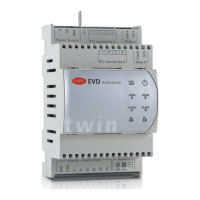ENG
“EVD Evolution TWIN” +0300006EN - rel. 2.6 - 31.01.2019
65
The subcooling measurement uses the dierence between the condensing
temperature taken from the relative pressure reading and the temperature of
the liquid refrigerant exiting the condenser. This measurement indicates the
refrigerant charge in the circuit.
A value near 0 K indicates possible insucient refrigerant, which may cause
a decline in circuit cooling eciency, a reduction in mass ow through the
expansion valve and swings in superheat control. In addition, it may indicate
a refrigerant leak in circuits where the nominal subcooling value is known.
A subcooling value that is too high, for example above 20 K, when not required
by the application may indicate excessive refrigerant charge in the circuit, and
can cause unusually high condensing pressure values with a consequent
decline in circuit cooling eciency and possible compressor shutdown due
to the high pressure switch tripping.
Reverse high condensing temperature protection
(HiTcond) on S3
The aim of reverse HiTcond protection is to limit the condensing pressure in
the refrigerant circuit by opening the valve rather than closing it. This function
is recommended, rather than the HiTcond protection function described
previously, in refrigerant circuits without a liquid receiver and where the
condenser is smaller than the evaporator (e.g. air-to-water heat pumps). In
this case, in fact, closing the valve would obstruct the ow of refrigerant to the
condenser that, lacking sucient volume for the refrigerant to accumulate,
would cause an increase in condensing pressure. This function is especially
useful for condensers in CO
2
cascade systems. See the chapter on Protectors.
S
F
M
V
EEV
CP
C
P
S2
S3
S1
EVD
evolution
P
T
E
Fig. 13.m
Key:
CP Compressor EEV Electronic expansion valve
C Condenser V Solenoid valve
F Filter-drier E Evaporator
S Liquid gauge P Pressure probe (transducer)
T Temperature probe
For the wiring, see paragraph “General connection diagram”
Important: opening the valve will probably also cause activation of
the low superheat protection LowSH, which tends to limit the opening of
the valve. The ratio between the integral times of these two concurrent yet
opposing protectors determines how eective one is compared to the other.
Reverse HiTcond (for CO
2
cascade systems)
Reverse high condensing temperature protection (HiTcond) on S3 is especially
useful for condensers in CO
2
cascade systems, where condensation in the low
temperature circuit (also called “secondary”, B) takes place when evaporating
the refrigerant in the medium temperature circuit (“primary”, A).
Parameter / Description Def.
SPECIAL
Refrigerant Alls refrigerants, not R744
Main regulation Subcooling regulation 1...10
Auxiliary refrigerant R744
Tab. 13.l
Nota: for this type of application, the auxiliary refrigerant must be set
as CO
2
(R744).ù
T1
P1
CHE
L1
F1
S1
V
M
EEV
CP1
EVD
evolution
S2S1 S4
S3
L2
F2
S2
CP2
A
B
E
T
V1
M
V2
P2
C
Fig. 13.n
Key:
CP1/2 Compressor 1/2 EEV Electronic expansion valve
CHE Cascade heat exchanger C Condenser
L1/2 Liquid receiver 1/2 V Solenoid valve
F1/2 Filter-drier 1/2 E Evaporator
S1/2 Liquid gauge 1/2 P1/2 Pressure probe (transducer)
T1 Temperature probe V2 Thermostatic expansion valve
For the wiring, see paragraph 2.11 “General connection diagram”
The driver controls refrigerant superheat in the primary circuit (A), and at the
same time measures the refrigerant condensing pressure in the secondary
circuit (B). When the condensing temperature exceeds the HiTCond protection
threshold, normal superheat control is overridden by forced opening of
the valve, at a rate that is inversely proportional to the HiTCond protection
integral time. Opening the EEV lowers the superheat in the primary circuit,
which increases the heat exchange coecient and consequently reduces the
condensing pressure in the secondary circuit.
The reverse HiTcond threshold for CO
2
cascade applications should be set in
relation to the expected evaporation temperature in the primary circuit. The
threshold must be set to a value that is at least 3-5°C higher than the minimum
evaporation temperature in the primary circuit. Lower values make achieving
the set pressure limit incompatible with heat exchange eciency. In addition,
swings in operation may occur due the attempt to limit low superheat in the
primary circuit and the pressure in the secondary circuit at the same time.
13.10 Variables used based on the type of
control
Vedere il manuale cod. +0300005IT.

